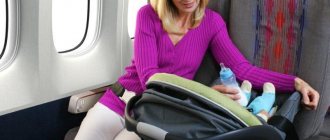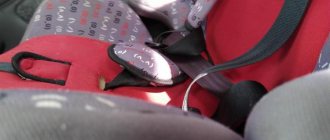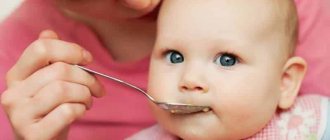Has there been an addition to your family recently? This means it’s time to think about how to spend your holidays in the next couple of years. Should you take a small child with you and how to fly with a baby? Or leave it to the grandmothers? It’s good if they are there and ready to help. If so, then you are lucky, but if not, I suggest you don’t hesitate and go on a trip with the whole family. For those who are scared of the first flight with a baby, I have prepared this article. In it I share my own experience of sharing flights with children under 2 years old.
Documents and tickets
Let's start with something pleasant: all children under 2 years old who do not occupy a separate seat fly for free.
But at the same time, you will definitely have to issue a ticket for a small passenger. There is some nuance here: one parent is allowed to transport only one child for free; for the second one you will have to pay a certain amount of the full cost of the ticket. If there are two parents, then it is possible to transport two children under two years of age free of charge. Necessary documents for your baby's flight
- birth certificate;
- baby’s international passport (for international flights);
- visa (for countries where it is required);
- notarized permission to fly abroad from the other parent if you are traveling without him.
Registration
Cost of accompanying a child on an airplane
When flying with children, it is better to check in online as soon as it opens. This will allow you to choose convenient seats and fly the whole family together. If this is not possible, then at the airport check-in counter you should ask for comfortable seats. Carriers have rules that require priority when boarding passengers with children. But if the plane is full, there is a possibility that only the mother and child will be placed in the safe seats at the front of the cabin, while the accompanying persons (including the father) will be in other places. When checking in at the airport, passengers with children must be allowed to skip the line.
Children without documents are not allowed to fly. On domestic flights, you must present your birth certificate upon boarding. When traveling abroad - a small passenger's international passport. If the child is accompanied by a third party, a notarized permission from the parents or guardians may be required for the child to travel abroad.
What to do with your child during a flight
“If a child is nervous in a separate seat during takeoff, you need to ask the flight attendant for a child’s belt, sit him on the lap (not the flight attendant, but the child) and fasten it to you.”
“During takeoff, she distracted attention - she asked me to hold my hand, feigned fear of flying, the child took care of his mother and was happy.”
“On long flights, be sure to let your baby walk/run/jump. At this age, it is difficult for children to sit in one place due to the growth of the musculoskeletal system. It’s also useful for adults to stretch their legs. Once we had a whole kindergarten in the back of the plane - five children entertained each other.”
“Not just to put a new coloring book or PSP in your hands, but to fully communicate, tell where we are flying, what we will do, play, draw together.”
“Looking through the window and explaining it is very entertaining.”
“When the child was tired, we wandered around the neighbors, changing the situation a little. Friendly neighbors on the plane were immediately present; a couple of minutes of cooing with someone else’s aunt gave 10-15 minutes of silence.”
“You don’t even have to play with the child, you can just talk. If you manage to talk with a child for an hour, it will forever remain in his memory. There is no need to look for ways to make the flight painless. It seems to me that you need to look for opportunities to enjoy it.”
“Preparing for food, eating and assembling trays is always mega fun. You may be allowed to take one of the sets of plastic cutlery with you, promising to then arrange a separate lunch for the toy characters.”
“The main thing is to alternate entertainment (distractions). There is little distraction for more than half an hour.”
“Read a book in a whisper, but it’s better from the age of 3, we take headphones with audio books (can listen for hours).”
“We definitely ask permission after landing (already at the exit) to look at the pilot. Usually possible for those who have behaved well. This won’t buy you a two-year-old, but at 3.5-4 years it will help you control yourself.”
Waiting at the airport
Registered. But there is still free time for a carriage and a small cart. What should I do to keep my child occupied?
At foreign airports there are entire entertainment centers for children. There are trampolines, balloons, slot machines, mazes... in general, everything that children like. At our airports, it’s good that at least a “Mother and Child” room is provided
Even if you are flying with a child who is almost a schoolboy, he should like the Mother and Child room. There are no suspicious adults there. Only parents and children. Most of these rooms still have some kind of toys, miniature role-playing sets (kitchens, hairdressers, gas stations, etc.). The room is equipped with comfortable upholstered furniture, and even cribs. Here you can calmly feed your child, change clothes, and lull him to sleep.
No matter what, no matter how much we distract the children, they still get tired.
Moreover, they get tired of everything. And from the fact that you need to sit in one place for a long time, and from moving from one location to another, and from the fact that you need to follow some rules, and from the fact that they are constantly kept in suspense: you can’t go there, you can’t go here, stand here, come here... Therefore, as soon as the opportunity arises, let them run, scream, fool around.
The correct model of behavior can be set by example.
For example, in order to calm my hyperactive son, I did not shout at him, and did not even look sternly at him. And she simply sat on the suitcase, demonstratively took out a book, and pretended to be reading with enthusiasm. Sometimes she even imitated a little laughter and some exclamations, like: “Well, it’s amazing!” And every time the son was hooked. He sat down next to him and asked: “What’s there?” And then the two of us looked at the pictures in the book. By the way, the eldest child learned the multiplication tables at the airport, during a flight delay. So, you can also learn while traveling.
The nuances of buying a ticket for a baby
Airlines provide discounts on tickets for children. The ticket of one of the parents indicates the details of the baby according to the birth certificate. The ticket price sometimes increases by 10%; some airlines indicate only the port tax in the ticket price.
If you are traveling with two children, you must book an additional seat. You need to find out prices and discounts from the dispatcher; they are different for each company. You need to ask about the availability of a child seat. If this is not the case, ask about the possibility of flying in a simple transport seat.
You also need to find out about a baby crib. When ordering a ticket, you must indicate your need for such a service. Some companies provide special bassinets for babies.
Choosing the best places
The best seats for babies are in the front row, where there is more space for a variety of grooming activities. But if it turns out that several families with infants are flying on board, there may not be such a place. There are companies that strictly allocate seats for children. When planning a flight with a baby, you need to book tickets in advance.
Preparation
After you have purchased your tickets, be sure to call the airline’s call center and discuss the flight details with the operator. If you are flying with several children, ask to be assigned seats next to you. This must be done immediately, without waiting for registration.
You can order a bassinet, which will make flying with an infant much easier. Baby food is also ordered.
As a rule, it includes several types of purees, milk, and cookies. If you notify the flight attendant after boarding the plane, you can get food at any time.
As for preparing your baby, it is advisable to visit a pediatrician and consult with him about the possibility of flying. It is not recommended to travel after vaccination if you are feeling unwell. You should also not introduce new foods into complementary foods at this time, as the baby’s body may react negatively.
For baby's comfort
There are also special hammock bassinets from Flyebaby that are convenient for transporting babies. On an airplane, the upper part of the hammock is attached to a table on the seat in front, and the bottom is secured with special belts around the mother’s waist. In the hammock itself, the child is secured with straps. Flyebaby is designed for children weighing up to 11 kg. This device is also convenient in everyday life: with its help, any chair can be turned into a children's chair. You can buy it here
In any case, no matter what you use, during takeoff and landing, as well as during turbulence, you will need to fasten your child to you with a special belt provided by the flight attendants. By the way, if you are a confident sling user or your child has already grown up to a special backpack, then maybe it’s even better to use them. Some children fall asleep on their parents, practically not noticing the flight itself.
Rules for flying with children
Before traveling by plane, it is advisable to know about important nuances regarding flight rules.
Parents should know:
We recommend reading: How to walk with a newborn baby
- If an infant under one to two years of age will be placed in the arms of mom or dad during domestic flights, then there is no need to buy a ticket for him. But this rule only applies to one child. If there are several children in a family, then tickets are usually purchased for the rest (regardless of age). True, various benefits are provided: a special discount of up to 50%, free baggage allowance (of a certain weight), etc. An international flight requires payment of 10% of the ticket price. This rule also applies to children under two years of age who do not occupy a seat in the cabin.
- Most airlines allow you to bring a baby carrier on board. But first, find out if the airline itself provides such a bassinet on your flight. The newborn will be better protected in it. With some airlines, this service must be ordered separately and in advance.
- You will only be allowed to use the stroller until boarding, then it will be moved to the luggage compartment of the aircraft. If you need the stroller later at the airport, it’s worth asking if they can give you a temporary replacement. Some airlines allow you to carry a cradle in the cabin, as well as a stroller of a specified weight and size. Some people need to negotiate. In this regard, urgent advice: check with your carrier’s information office for the rules regarding the stroller and cradle.
- When purchasing tickets, you should immediately say that you are going to fly with a small child. And don’t forget to bring documents confirming the age of the baby. You will definitely be asked for them.
- The air carrier is obliged to provide families with young children with the most comfortable and safest seats on the plane. This is usually the beginning of the cabin or the first row. And if the vehicle is half empty, then the seats that will be in front of you should be free.
Some flights offer seats with bassinets. Typically, they are in the front row of the plane. Seats with a bassinet must be booked in advance
Flying with a baby - our experience and useful tips
At what age can you fly? Airline websites include a warning that doctors do not recommend transporting newborns under seven days of age. Otherwise, there are no other restrictions.
The beautiful truth is that the younger the child, the easier it is to fly with him, since the likelihood is that he will simply sleep for most of the flight.
But when a child begins to walk, it is more difficult to keep him in place. Although, sometimes new experiences and the opportunity to rush around at the airport do their job, and the child passes out on board, but this is far from the rule.
Our flights
Last year there were only two trips, but I counted nine flights.
At 5 months we flew to Florida: 4 hours from Novosib to Moscow, a transfer and then (oh horror) almost 13 hours to Miami, such a difficult flight it was. Fortunately, my son slept through half of these flights, and the second he walked on his parents’ arms, the cradle and the floor in front of the seats - we were sitting in the first row and there was not much space, but there was still some. Our neighbors on the flight, sitting across the row, laid out a blanket for their 9-month-old daughter and threw in toys, so it turned out to be a playground. According to security requirements, this cannot be done, but since no one forbade them, it was very convenient.
So Gleb Alekseevich met his six months on the ocean, and his parents had a good time. Then there was another flight to New York and the road back to my native Siberia, but all the flights overall went well.
Another time we flew to Spain, Gleb was already 8-9 months old, we again flew 4 hours to Moscow and another 4.5 hours to Barcelona, and then back.
Before the flight
Under the age of two years, a child is called an infant and in most cases flies for free, without being provided with a separate seat. After 2 flights, you can only fly on a separate seat, but with a significant discount (unless it’s a charter).
As a rule, no additional payments are required within the country. For international flights, an additional payment is introduced, the so-called “boarding pass fee,” which can be about 10% of the ticket price or a fixed cost for charters. For a small child there is a free baggage allowance, for example, for Aeroflot it is 10 kg.
Since 2010, children have ceased to be included in their parents’ passports (except in exceptional cases) and travel requires their own, separate passport. Yes, even if the child is 2 months old (Resolution of the Government of the Russian Federation of January 19, 2010 No. 13 on the procedure for using passport forms for a citizen of the Russian Federation). You can enter this into the passports of the new generation of children, but this entry does not give any bonuses - you still need your own passport and you still need to take your birth certificate with you. This is an important document that should not be forgotten.
In addition to the certificate, consent to remove the child may sometimes be required. If a child is flying with one of the parents, and the second has not sent any restrictions on travel, then the consent of the second parent is not required. However, some countries, for example, the Schengen countries, set their own rules for entering the country, and following them, you will have to agree, otherwise you will simply not be issued a visa. Consent will also be required if a child is flying without parents, even if he is accompanied by grandparents. You can read more about this on the website of the Russian Border Service.
If you have a choice, I advise you to give preference to regular flights and trusted airlines. Yes, if it's not on sale, then all other things being equal, the ticket will most likely be more expensive, but you will significantly reduce the likelihood that your flight's departure time will change at the last minute, and you will also increase the likelihood that you will be provided with a bassinet and baby on board food, the level of service will be higher, and the distance between the seats will be a couple of centimeters greater.
Cradle
For babies, some airlines provide bassinets on board. To book it, you must contact the airline representative no later than 36 hours before departure. Carrycot availability may be determined by airline and aircraft type. It happened to us that during a transit flight, there was a cradle on one leg of the flight, but not on another.
All children are different and mine slept well in my arms, I even managed to eat. It’s true that your hands get numb during a long flight.
A blanket, pillow and disposable bed linen are usually provided with the cradle.
Stroller
The stroller is not considered baggage and, as a rule, is accepted for transportation free of charge. But how exactly your stroller will be accepted is a question. Somewhere the stroller is taken away along with your luggage, but in order to get to the ramp they may be given a separate stroller for use.
Sometimes the stroller can be picked up at the gangway and given back to him, having attached a special tag, and sometimes they are picked up at the gangway and only given out with luggage, and before that you will have to drag yourself with the child and hand luggage on you. It’s better to check with the airline in advance what awaits you.
For travel, we chose a stroller that folds not into a cane, but into a bag that can be transported as hand luggage. It’s very convenient, you don’t have to worry about it being smashed to pieces when transported in the luggage compartment, and it’s always nearby, because sometimes the road from the ramp to passport control can be a couple of kilometers
However, incidents also happened with it, since airline representatives were not aware of the capabilities of such strollers, they already hung up a check-in tag at the ramp, and then left it with us when they saw it folded. We have Babyzen YOYO, friends bought Rekaro and say that it has similar capabilities.
Takeoff and landing
A child who flies in the arms of his parents is fastened to his parent with a special belt during takeoff and landing. The flight attendants will tell you how to use it. The belt does not interfere with breastfeeding.
The cradle is removed during takeoff and landing and cannot be used.
Many people may experience stuffy ears when ascending and descending, and children may begin to behave restlessly and cry. To minimize these unpleasant sensations, it is recommended to put the baby to the breast or give him water to drink.
My son calmly ate his breasts and most often passed out; I got the impression that changes in altitude did not bother him at all. Unlike his mother.)
Another tip is to put aquamaris in your nose before takeoff, and possibly repeat this during the flight. The air on the plane is very dry and the mucous membrane dries out instantly. And this is unpleasant - first, and secondly - this is an open road for all sorts of pathogenic microbes. So it's better to moisturize.
What to take on board?
- food and water.
They are allowed in in any quantity and absolutely without problems if you are flying with a child. You can always ask the flight attendants for hot water if necessary. In some airlines you can order baby food, the composition should be clarified in advance, but this is more of a bonus, and you take the main food.
Of course, the most convenient thing is when the baby is breastfed. Here he has food and water, and mom has a minimum of bottles with her.
If the child is older, then you can grab snacks, cookies or crackers, which will give you the opportunity not only to refresh yourself, but also to captivate you for a short time.
It is most convenient to take purees in soft packages; the child can simply suck out the contents, while leaving his hands and everyone around him clean.
Also, if complementary feeding has already begun, disposable bibs may be useful. After eating I just threw it away and didn’t need to wash anything.
- diapers, wet wipes and disposable diapers.
The diaper is useful for placing on the changing table on the plane or at the airport. You can calculate the required number of diapers yourself, but take a few with a reserve. You should take more wet wipes. The plane is very cramped, narrow and there is no way to properly wash the child, so napkins are the main lifesaver.
- change of clothes
Anything can happen in flight... so it’s better to take it. I forgot this point a couple of times and then it was very difficult to get out. So take it!
- new toys
Initially, the new environment captivates the child most of all, but as he gets used to it, it becomes more difficult to keep him in place (unless he is just a toddler). This is where toys can come to the rescue, and it is advisable to stock up on new ones, ones that will captivate the child for a longer time. At 5-6 months we had rubber rattles that could be chewed, all sorts of rattles that made noise (but not so loud as to irritate the neighbors). For children after a year, you can already try to grab salt dough or a piece of plasticine, an album with stickers (there are some from a year old, it’s difficult for my son to peel it off himself, but he really likes to stick it), and also our hit - a jar of beans. It can take a very long time to put one in a jar and go back to sleep. An alternative to this is beaded lacing.
Another trick is a tablet filled with cartoons and games. I know for sure that mine would be captivated by this for a long time, but for now I keep this technique among the prohibited ones, since we are in no hurry to introduce gadgets.
- first aid kit
With the birth of my child, the set of medicines that I began to carry with me increased significantly. Depending on the situation, part of the first aid kit can be checked into your luggage, and some items can be taken with you. Which ones exactly - depend on the situation, but you definitely need to grab aquamaris; It is highly not recommended to fly with a stuffy nose, so drip Nazivin if necessary; Some mothers recommend taking Nurofen or Panadol in your hand luggage. As for the rest of the list, it’s different for everyone, the last time I had it it looked something like this:
- antipyretic and analgesic - nurofen, panadol
- anti-allergy medications - pediatricians recommend Suprastin, but we had Fenistil
- means for treating wounds and scratches - plasters and miramistin, bandage
- remedies for the common cold - aquamaris, Nazivin, nozzle-type patches and isofra
- thermometer
— Bepanthen or d-panthenol
— Smecta or analogues
— rehydron (gastrointestinal tract, restoration of water balance, poisoning, intestinal infections)
- and other means that you consider necessary.
Whatever the first aid kit, don’t forget about health insurance - this is the very thing you shouldn’t skimp on.
And have a good flight!
I tried to cover all the main issues related to the flight, based on my own experience, the experience of friends and tourists with whom I worked as a travel agent.
But if I forgot something, ask, I’ll add to the post.
Original post on my website.
At what age can you fly?
As mentioned above, for certain physiological reasons, flying is undesirable in the first 2 weeks of a baby’s life. In the future, before deciding to fly, you should consult with your treating pediatrician, who will recommend certain vaccinations for the newborn (if they are needed) and make a conclusion about his health. If he sees no obstacles to such a journey, then feel free to make it.
Babies who can already sit and crawl are very active. You will have to do something to keep your child entertained. For these purposes, you should take his favorite toy, book or something else with you.
Many mothers who describe their experience of flying with children say that, for example, it is easier to fly with a one-month-old child than with a six-month-old. The fact is that such babies sleep most of the time. But a six-month-old toddler and older children are already showing curiosity, they quickly get tired of sitting in their arms, and they demand movement. And these kids have more than enough energy! Flying can be very tiring.
And what can I say, people nearby may not like such noisy behavior of the children. Some of them are even capable of showing aggression.
Flying with a baby - pros and cons
You can fly with newborns starting from 7 days from birth. Of course, provided that the child is healthy and the pediatrician gives the go-ahead for the flight. A pleasant bonus for parent travelers from air carriers is the opportunity to transport children for free until they reach the age of 2. It is clear that many are in a hurry to take advantage of this tempting offer and actively travel with small children. You need to keep in mind that if you want your child to sit not on your lap, but in a separate seat during the flight, you will have to buy him a ticket at the child fare. This is especially important on long flights.
Children under 2 years of age can fly for free on the lap of one of their parents
When it comes to air travel with infants, our society is still divided into two opposing camps. The first group includes ardent opponents of flying with babies. These people are sincerely convinced that traveling and flying are terribly harmful for children. That infants experience incredible pain during the flight, and their parents are real sadists and terrible egoists, thinking only about their own pleasure. This category, as a rule, includes people who either do not have children or those whose children have grown up long ago. The second camp is actively traveling parents. They don't want to leave their children in the care of their grandmothers or give up vacations that involve flying.
How to fly with a child
Let's look in detail at how to organize a flight with a child so that it doesn't turn into a nightmare.
Order a cradle
Some airlines offer seats with hanging or folding bassinets for flights with a child under one year old.
A bassinet is provided on large aircraft (usually Airbus 330, Airbus 340, Boeing 767, Boeing 777) for babies weighing up to 11 kg and up to 1 year of age.
You must notify about its need at least 36 hours before departure. The number of bassinets is limited and they are provided to those passengers who apply first.
If there is no cradle, you can ask for a child's belt that is fastened to an adult.
Stroller
Often, parents who are about to fly with small children under one year old want to take a stroller on the trip.
The following children's transport meets the requirements:
- A cane stroller weighing no more than 4.5 kg, measuring 53 * 27 * 97 cm. Can be taken to the salon.
- A stroller weighing no more than 20 kg, without original packaging. Can be checked in as luggage.
If your ears are blocked
There are several ways to deal with the problem of blocked ears in babies during takeoff and landing of an airplane.
The simplest method, which is perfect for flying with a one-year-old child or younger, is to give him a breast or a bottle with a pacifier.
For children over the age of four, you can prepare a sippy cup and ask the child to drink from it in small sips.
Recommendations for older children:
- apply hot plastic cups to your ears (you can put hot napkins in them or ask the flight attendant to pour boiling water into them, and then throw them out and apply the empty ones);
- blow into a tube;
- use drops.
If you get motion sickness
Children rarely get motion sickness on an airplane, even those for whom every short car trip turns into a big problem.
However, if you are unlucky, it is worth preparing for the flight:
- do not feed your child heavily 1.5 hours before takeoff;
- children over two years old should be given special medications, for example, Dramamine, after consulting with a pediatrician;
- take sucking candies with mint or sour taste;
- Prepare bags in case vomiting starts.
What to do with a little passenger
The younger the child, the less entertainment he needs. For example, for a flight with a one-month-old baby, a mother’s breast and a couple of toys will be enough.
For older children, you can take your favorite toys and new ones that the baby has not yet seen. Several books selected on the same principle would be useful.
Coloring books, magazines with stickers, and interactive books keep children occupied for a long time. A child over 4 years old can take headphones and record several audio performances on a player or phone.
From 6–7 years old, a tablet with games and cartoons will be useful, as well as board games, puzzles with large parts, and small construction sets in a box so as not to lose the details.
What to eat
As we have already mentioned, major airlines provide special meals for children, the main thing is not to forget to order it in advance.
If such a service is not provided, you can take your usual food from home in containers. Baby food should be bottled in containers up to 100 ml.
For a snack, you can take cookies, nuts, fruits, drinking yogurt, juice, and a milkshake.
How to replace a doctor?
If your ears are blocked. Due to pressure changes during takeoff and landing, children may experience discomfort in their ears. A pacifier or bottle will save your baby; it is better to give babies water so they can drink in small sips. Older children can snack on fruit or suck on a piece of candy. Yawning also helps equalize pressure.
If the child also has a runny nose. The child must take vasoconstrictor drops before the flight, having consulted with the doctor the day before. During the flight, you should rinse your nose with saline solution once an hour. By the way, this is also recommended for healthy children to moisten the nasal mucosa in dry air conditions in the cabin.
If you get seasick. Mint candies or lemon slices will help. There are hygiene bags on board; you can ask the flight attendant for them or bring your own.
Possible consequences
- Pressure changes can lead to blocked ears and headaches. In an adult, these phenomena can be short-term, while in a small child, especially in an infant, they can be longer.
- Toddlers are extremely susceptible to atmospheric pressure. If it changes, severe ear pain and dizziness may occur. The child will be capricious.
- It is believed that during a flight of several hours, ear pain can develop into an inflammatory process (otitis media).
- If the little one flies with a runny nose, the flight can lead to nasal congestion and lack of normal breathing. In this case, the development of otitis media is also possible.
What do you need to take on board?
Particular attention is paid to packing a bag for traveling with a baby. For this purpose it is going to:
For this purpose it is going to:
- two sets of changing clothes for the baby and for the mother;
- separately – a package with care products;
- thick bags for used diapers or soiled clothes;
- a blanket or flannelette diaper - to cover the baby while sleeping;
- several favorite toys;
- first aid kit with necessary medications.
Stroller
A baby stroller with cleaned wheels will be handed over at the boarding ramp; you can receive it when leaving the plane or along with baggage claim. You are only allowed to take a portable cradle from a stroller into the cabin, which will be inspected before boarding.
Baby food and water
For infants, you can take water with you in a sealed bottle. For artificial feeding, you can take a certain amount of food, but indicate this when ordering a ticket. It is also necessary to inform about the amount of food if the child has allergies and other food is not suitable for him. For meals, you need to use a temperature-controlled bag so that the food does not spoil.
If you are traveling to big cities, you can buy everything you need there. Some airlines provide baby food, milk, various types of purees, cookies, and fruits on the menu.
Spare clothes
It is imperative to take spare clothes. Two sets of clothes for changing the baby and an additional set for the mother, since while eating the child can get dirty himself and his mother. You also need clothing if the plane cabin is hot or cold. Traveling in winter requires insulated outer clothing (an additional bag is required to store it).
First aid kit
The first aid kit should be folded according to the list compiled by the pediatrician:
- medications the child is currently taking;
- wet wipes with disinfectant properties;
- fever-reducing tablets;
- stomach upset medications;
- moisturizing nose drops.
Nasal drops are required to moisturize the nasal mucous membranes during takeoff, landing and flight in the aircraft cabin, where the air is quite dry. For the smallest children, it is enough to drink from a bottle of water or suck on a pacifier (with the swallowing reflex, the ear canals will return to normal).
Care items
Almost all lavatories on airliners are equipped with a changing table. They are convenient for changing your baby's clothes and changing a diaper. The baby care kit should contain:
- diapers;
- baby cream;
- wet and paper wipes;
- disposable and reusable diaper;
- nursing apron;
- 2-3 pacifiers.
Pacifiers must be in sealed packaging. The necessary item is a thick plastic bag for used diapers and wipes.
About the stroller
We took a stroller with us, but already at the boarding ramp it had to be checked in as luggage. In Bali it was not at all useful, but at Doha International Airport, where we had a layover, you can rent a stroller completely free of charge. On top of that, my daughter loves to ride on special luggage trolleys. So, instead of dragging an extra load, it’s better to find out what the conditions are like on the roads and sidewalks at your destination











